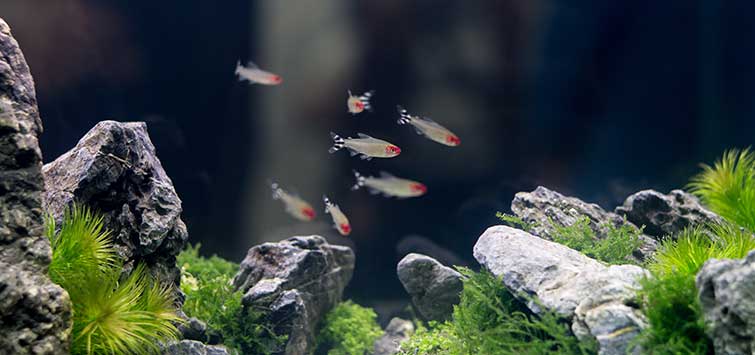An Iwagumi Layout with Radially Arranged Stones
Author: Takashi Amano, translated by Tomoko Schum
Many different stones may be used in iwagumi layouts. Master aquascaper Takashi Amano discusses one popular and readily available kind—ryuoh seki—and describes its use in his recent aquascape.
Various iwagumi layouts have been produced in the Nature Aquarium style. Stones are an effective way to express the flow of water in a layout, and the resulting iwagumi layout tends to produce an impression quite similar to that of a natural waterscape. Several types of stones are often used in iwagumi layouts; they have become standards after years of use in various iwagumi layouts.
Stones for the Nature Aquarium
Some types of stones are no longer used in my layouts, although they have been tried in the past. Such stones might have produced an image that was not quite natural for an aquascape. In the Nature Aquarium, stones and driftwood with unnatural appearances are generally weeded out, despite their being natural materials. However, some stones and driftwood types are no longer used simply because they became unavailable at the source. So the stones that are old standbys in the Nature Aquarium both have a natural appearance and are in relatively good supply.
Ryuoh-seki Stone Essentials
Ryuoh-seki stone is one such standard layout material. Since ryuoh-seki stones come in a variety of shapes, the image of an iwagumi layout can be altered greatly depending on the shape of the stones you choose. The arrangement of the iwagumi layout in this article was created by selecting ryuoh-seki stones with sharp tips.
The characteristic textures, white striations, and shapes of ryuoh-seki are the results of the way they were formed. Ryuoh-seki is originally a bluish sedimentary rock. Magma penetrated through the rock deep in the ground and formed the white-colored layer. When the ground thrust upward and exposed the rock to water, the characteristic texture and grooves seemed to have formed and the rock fractured into various shapes. The tectonic movement of the earth over an extremely long period produced the unique form of ryuoh-seki.
Although it was influenced by water, ryuoh-seki has a ragged shape unlike a roundish river stone. This is the result of gradual erosion by rainwater. The stone was named ryuoh-seki(originally named seiryu-seki when it was introduced) after a legendary dragon in Eastern mythology. Since its cool, bluish color goes together well with green aquatic plants and the shape is good for conjuring up the image of a natural landscape, the stone became an old standby as a layout material for an iwagumi layout. When I produce an iwagumi aquascape with ryuoh-seki, I try to create a layout that makes the most of the characteristic appearance of the stones.
Using Ryuoh-seki in a Layout
Ryuoh-seki stones come in various shapes. The way they are used in a layout depends on their shape. In the case of ryuoh-seki stones that are relatively narrow and long with sharp tips, such as those in the layout featured in this article, standing them somewhat upright produces a more powerful layout than laying them down.
This layout was produced by keeping in mind an image of radial lines spreading from the center. This type of stone arrangement produces an impression of water flowing from the back of the aquarium toward the front. Soil was mounded higher in the rear-center of the aquarium to enhance the impression of water current. Then, short aquatic plants were planted according to the basic rule of an iwagumi aquascape.
The back of the stone arrangement was planted with Echinodorus tenellus, which is relatively taller than the other short aquatic plants. The front of the stones was planted with Glossostigma, cobra grass, and Riccia. Planting a few different types of short aquatic plants together gives a variation in the appearance of the foreground area. Since these plants, except for Riccia, spread by runners, they gradually intermingle with each other by sending runners as they grow. These few aquatic plants were planted together since the appearance of mixed plants feels very natural.
Arrangement Maintenance
This arrangement is also very easy to maintain, since you can trim them together at the top to create an even surface. As time passes, different plants dominate the scene at different times. Glossostigma was dominant in the foreground when this picture was taken. Riccia was held down by the runners of Glossostigma and, therefore, was less buoyant than it was when planted by itself. I recommend that you give this technique a try to maintain Riccia over a long period.
See the full article on TFH Digital




